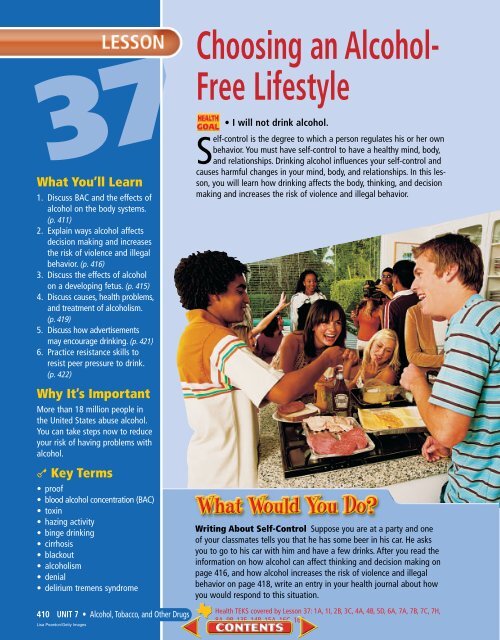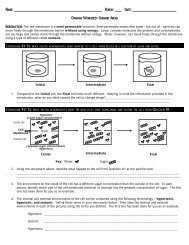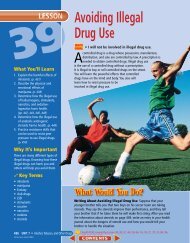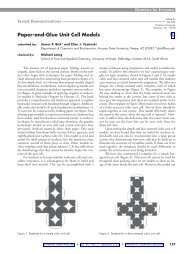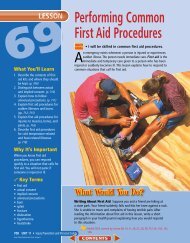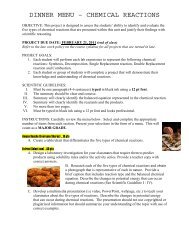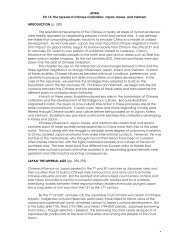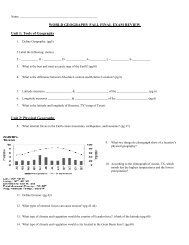Lesson 37 Choosing an Alcohol-Free Lifestyle - Epsilen
Lesson 37 Choosing an Alcohol-Free Lifestyle - Epsilen
Lesson 37 Choosing an Alcohol-Free Lifestyle - Epsilen
You also want an ePaper? Increase the reach of your titles
YUMPU automatically turns print PDFs into web optimized ePapers that Google loves.
<strong>37</strong><br />
What You’ll Learn<br />
1. Discuss BAC <strong>an</strong>d the effects of<br />
alcohol on the body systems.<br />
(p. 411)<br />
2. Explain ways alcohol affects<br />
decision making <strong>an</strong>d increases<br />
the risk of violence <strong>an</strong>d illegal<br />
behavior. (p. 416)<br />
3. Discuss the effects of alcohol<br />
on a developing fetus. (p. 415)<br />
4. Discuss causes, health problems,<br />
<strong>an</strong>d treatment of alcoholism.<br />
(p. 419)<br />
5. Discuss how advertisements<br />
may encourage drinking. (p. 421)<br />
6. Practice resist<strong>an</strong>ce skills to<br />
resist peer pressure to drink.<br />
(p. 422)<br />
Why It’s Import<strong>an</strong>t<br />
More th<strong>an</strong> 18 million people in<br />
the United States abuse alcohol.<br />
You c<strong>an</strong> take steps now to reduce<br />
your risk of having problems with<br />
alcohol.<br />
k Key Terms<br />
• proof<br />
• blood alcohol concentration (BAC)<br />
• toxin<br />
• hazing activity<br />
• binge drinking<br />
• cirrhosis<br />
• blackout<br />
• alcoholism<br />
• denial<br />
• delirium tremens syndrome<br />
410 UNIT 7 • <strong>Alcohol</strong>, Tobacco, <strong>an</strong>d Other Drugs<br />
Lisa Peardon/Getty Images<br />
<strong>Choosing</strong> <strong>an</strong> <strong>Alcohol</strong>-<br />
<strong>Free</strong> <strong>Lifestyle</strong><br />
• I will not drink alcohol.<br />
Self-control is the degree to which a person regulates his or her own<br />
behavior. You must have self-control to have a healthy mind, body,<br />
<strong>an</strong>d relationships. Drinking alcohol influences your self-control <strong>an</strong>d<br />
causes harmful ch<strong>an</strong>ges in your mind, body, <strong>an</strong>d relationships. In this lesson,<br />
you will learn how drinking affects the body, thinking, <strong>an</strong>d decision<br />
making <strong>an</strong>d increases the risk of violence <strong>an</strong>d illegal behavior.<br />
Writing About Self-Control Suppose you are at a party <strong>an</strong>d one<br />
of your classmates tells you that he has some beer in his car. He asks<br />
you to go to his car with him <strong>an</strong>d have a few drinks. After you read the<br />
information on how alcohol c<strong>an</strong> affect thinking <strong>an</strong>d decision making on<br />
page 416, <strong>an</strong>d how alcohol increases the risk of violence <strong>an</strong>d illegal<br />
behavior on page 418, write <strong>an</strong> entry in your health journal about how<br />
you would respond to this situation.<br />
Health TEKS covered by <strong>Lesson</strong> <strong>37</strong>: 1A, 1I, 2B, 3C, 4A, 4B, 5D, 6A, 7A, 7B, 7C, 7H,<br />
8A, 9B, 13E, 14B, 15A, 16C, 16D
Adrug that depresses the brain <strong>an</strong>d nervous system is alcohol. <strong>Alcohol</strong> is made by<br />
fermentation. Fermentation is a process in which yeast, sugar, <strong>an</strong>d water are<br />
combined to produce alcohol <strong>an</strong>d carbon dioxide. The most common alcoholic<br />
beverages are beer, wine, <strong>an</strong>d liquor.<br />
What to Know About <strong>Alcohol</strong><br />
<strong>an</strong>d the Body<br />
Beer An alcoholic beverage that is<br />
made by fermenting barley, corn, or<br />
rye is beer. Most beers are about 4<br />
percent alcohol. Malt liquor is beer<br />
that has a higher alcohol content th<strong>an</strong><br />
regular beer. Light beer is beer that<br />
has fewer calories th<strong>an</strong> regular beer,<br />
but about the same alcohol content.<br />
Wine An alcoholic beverage made by<br />
fermenting grapes or other fruits<br />
is wine. Most wines are about 12 to<br />
14 percent alcohol. A wine cooler is<br />
a carbonated, fruit-flavored alcoholic<br />
beverage that is 1.5 to 6 percent<br />
alcohol.<br />
Liquor An alcoholic beverage that is<br />
made by distillation is liquor.<br />
Distillation is a process that uses a<br />
fermented mixture to obtain <strong>an</strong> alcoholic<br />
beverage with a high alcohol content.<br />
Whiskey, bourbon, rye, rum, gin,<br />
vodka, tequila, <strong>an</strong>d br<strong>an</strong>dy are types of<br />
liquor. Most liquors are about 40 percent<br />
alcohol. A measure of the amount<br />
of alcohol in a beverage is the proof of<br />
the liquor. The proof of a beverage is<br />
double the percent of alcohol in the<br />
beverage. For example, a beverage<br />
with 20 percent alcohol is 40 proof.<br />
tx.healthmh.com/alcohol<br />
How <strong>Alcohol</strong> Enters the Body<br />
<strong>Alcohol</strong> enters the bloodstream within<br />
minutes. About 20 percent of the alcohol<br />
that a person drinks is absorbed<br />
into the bloodstream through the<br />
walls of the stomach. A majority of the<br />
rest of the alcohol is absorbed through<br />
the walls of the intestine. After it is<br />
absorbed, alcohol moves quickly into<br />
the bloodstream. The remaining alcohol<br />
is excreted through urine, perspiration,<br />
or breath.<br />
<strong>Alcohol</strong> affects every cell in the body.<br />
Most of the alcohol is ch<strong>an</strong>ged to<br />
harmless waste by the liver. The<br />
liver c<strong>an</strong> process only about one<br />
drink per hour. If a person has more<br />
th<strong>an</strong> one drink, the excess alcohol<br />
builds up in the body. The alcohol in<br />
a drink goes to the body tissues<br />
before being excreted. The effects of<br />
alcohol intensify as the concentration<br />
of alcohol in the blood increases. The<br />
amount of alcohol in a person’s blood<br />
is the blood alcohol concentration<br />
(BAC). BAC is given as a percentage.<br />
The higher the BAC, the greater the<br />
effects of alcohol on the body.<br />
Mini-Review<br />
1. Describe<br />
fermentation.<br />
2. What percentage<br />
of alcohol is<br />
absorbed into the<br />
bloodstream<br />
through the walls<br />
of the stomach?<br />
3. If a beverage has<br />
50 percent alcohol,<br />
what is the proof<br />
of the beverage?<br />
LESSON <strong>37</strong> • <strong>Choosing</strong> <strong>an</strong> <strong>Alcohol</strong>-<strong>Free</strong> <strong>Lifestyle</strong> 411
Others may pressure<br />
you to have “just one<br />
drink,” but remember<br />
that all alcoholic<br />
beverages are toxins.<br />
<strong>Alcohol</strong> Expenses<br />
The total cost of<br />
alcohol use by youth<br />
(including car crashes,<br />
crime, alcohol<br />
poisonings, fetal<br />
alcohol syndrome,<br />
etc.) is more th<strong>an</strong> $58<br />
billion per year.<br />
One-half ounce is one drink. An alcoholic<br />
beverage that contains about<br />
one-half ounce of alcohol is considered<br />
one drink of alcohol. One-half ounce<br />
of alcohol is about the amount of alcohol<br />
in one c<strong>an</strong> of beer, 4 to 5 ounces of<br />
wine, or one mixed drink. Drinking<br />
more th<strong>an</strong> this causes BAC to rise.<br />
<strong>Alcohol</strong> is a toxin. A toxin is a subst<strong>an</strong>ce<br />
that is poisonous. If too large<br />
<strong>an</strong> amount is swallowed, the stomach<br />
will reject it. This causes a person to<br />
vomit. The body attempts to break<br />
down alcohol as quickly as possible to<br />
remove it from the body. However, a<br />
large amount of alcohol in the body<br />
takes a long time to be excreted. This<br />
is why people who drink alcohol at<br />
night may still feel its effects the next<br />
morning. These people may still be<br />
“drunk” the next day. There is no way<br />
to speed alcohol through the body.<br />
Coffee, showers, <strong>an</strong>d fresh air do not<br />
break down alcohol.<br />
Factors That Affect BAC<br />
412 UNIT 7 • <strong>Alcohol</strong>, Tobacco, <strong>an</strong>d Other Drugs<br />
(tt)Photodisc/Getty Images<br />
Amount of alcohol consumed The<br />
number of drinks people have affects<br />
their BAC. The alcohol content of<br />
each drink determines the effects of<br />
the alcohol.<br />
Speed at which alcohol is consumed<br />
Drinking at a faster rate increases<br />
BAC. Drinking alcohol quickly is<br />
d<strong>an</strong>gerous <strong>an</strong>d c<strong>an</strong> be fatal. When<br />
people consume several alcoholic beverages<br />
in a short period of time, the<br />
liver does not have time to break<br />
down the alcohol.<br />
Body weight People with a higher<br />
body weight have a higher volume of<br />
blood th<strong>an</strong> people with less body<br />
weight. The same amount of alcohol<br />
produces a greater effect on people<br />
with less body weight.<br />
Percentage of body fat Body fat does<br />
not absorb as much alcohol as le<strong>an</strong><br />
body tissue. A person with the higher<br />
percentage of body fat will have a<br />
higher BAC after one drink th<strong>an</strong> a<br />
person with a lower percentage of<br />
body fat.<br />
Gender BAC rises faster in females<br />
th<strong>an</strong> in males. Females usually have<br />
a higher percentage of body fat th<strong>an</strong><br />
males. Certain hormones make<br />
females more sensitive to the effects<br />
of alcohol th<strong>an</strong> males. Females also<br />
have less of a certain stomach<br />
enzyme that breaks down alcohol<br />
before it enters the bloodstream.<br />
Feelings Feelings, such as stress,<br />
<strong>an</strong>ger, <strong>an</strong>d fear, c<strong>an</strong> affect BAC by<br />
speeding up the time it takes alcohol<br />
to enter the bloodstream.<br />
Amount of food eaten <strong>Alcohol</strong> passes<br />
more quickly into the bloodstream<br />
when the stomach is empty th<strong>an</strong><br />
when it is full.<br />
Presence of other drugs in the bloodstream<br />
The presence of certain drugs<br />
in the bloodstream increases the<br />
effects of alcohol. For example, tr<strong>an</strong>quilizers<br />
<strong>an</strong>d painkillers increase the<br />
depress<strong>an</strong>t effects of alcohol.
Age Elderly people are more sensitive<br />
to the effects of alcohol th<strong>an</strong> are<br />
younger people. The bodies of elderly<br />
people contain a lower volume of blood<br />
th<strong>an</strong> the bodies of younger people.<br />
Drinking carbonated alcoholic beverages<br />
The alcohol in carbonated beverages<br />
passes into the bloodstream more<br />
quickly th<strong>an</strong> the alcohol in noncarbonated<br />
drinks.<br />
Drinking Games <strong>an</strong>d Hazing<br />
Drinking c<strong>an</strong> be a hazing activity. An<br />
activity in which a person is forced to<br />
participate in a d<strong>an</strong>gerous or deme<strong>an</strong>ing<br />
act to become a member of a club or<br />
group is a hazing activity. Some teens<br />
have died from these hazing activities.<br />
Hazing activities are against the law in<br />
most states, <strong>an</strong>d these hazing activities<br />
violate the rules of most schools.<br />
Drinking games c<strong>an</strong> be life-threatening.<br />
Drinking alcohol quickly—chugging,<br />
doing shots, or funneling—is especially<br />
d<strong>an</strong>gerous. Binge drinking also is<br />
extremely d<strong>an</strong>gerous. Consuming<br />
large amounts of alcohol in a short<br />
amount of time is called binge drinking.<br />
People may become unconscious<br />
or d<strong>an</strong>gerously drunk. Drinking games<br />
are d<strong>an</strong>gerous <strong>an</strong>d are considered<br />
binge drinking.<br />
What Happens as BAC<br />
Increases<br />
BAC .02 People feel relaxed. They<br />
may have increased social confidence<br />
<strong>an</strong>d become talkative. Thinking <strong>an</strong>d<br />
decision-making abilities may be<br />
impaired.<br />
BAC .05 Areas of the brain that control<br />
reasoning <strong>an</strong>d judgment are<br />
impaired. People feel warm, relaxed,<br />
<strong>an</strong>d confident. Speech may be<br />
slurred. People may say or do things<br />
they usually would not say or do.<br />
There is a decrease in muscular coordination,<br />
<strong>an</strong>d reaction time is slowed.<br />
BAC .08–.10 Reasoning, judgment,<br />
self-control, muscular coordination,<br />
<strong>an</strong>d reaction time are seriously<br />
impaired. People no longer c<strong>an</strong> make<br />
responsible decisions. However, they<br />
may claim not to be affected by the<br />
alcohol. They have slurred speech <strong>an</strong>d<br />
walk with a stagger. In most states,<br />
they are considered legally drunk.<br />
BAC .12 People usually become confused<br />
<strong>an</strong>d disoriented. People may<br />
have loss of control of coordination<br />
<strong>an</strong>d bal<strong>an</strong>ce. People become nauseous<br />
<strong>an</strong>d vomit.<br />
BAC .20 Emotions are unpredictable<br />
<strong>an</strong>d may ch<strong>an</strong>ge rapidly. For example,<br />
people may quickly switch from crying<br />
to laughing. They may pass out.<br />
BAC .30 People will have little or no<br />
control over their minds <strong>an</strong>d bodies.<br />
Most people c<strong>an</strong>not stay awake to<br />
reach this BAC.<br />
BAC .40 People are likely to be unconscious.<br />
Breathing <strong>an</strong>d heartbeat slow<br />
down. Death c<strong>an</strong> occur.<br />
BAC .50 People may enter a deep<br />
coma <strong>an</strong>d die.<br />
<strong>Alcohol</strong>-related auto accidents<br />
are high among teens.<br />
Mini-Review<br />
1. Why are elderly<br />
people more<br />
sensitive to the<br />
effects of alcohol<br />
th<strong>an</strong> younger<br />
people?<br />
2. What effect<br />
does food in the<br />
stomach have<br />
on absorption<br />
of alcohol?<br />
3. What effect does<br />
carbonation have<br />
on the absorption<br />
of alcohol?<br />
tx.healthmh.com/alcohol LESSON <strong>37</strong> • <strong>Choosing</strong> <strong>an</strong> <strong>Alcohol</strong>-<strong>Free</strong> <strong>Lifestyle</strong> 413<br />
Kenji Kerins
Make the<br />
Connection<br />
Body Systems For<br />
more information on<br />
how body systems<br />
work, see page 208 in<br />
<strong>Lesson</strong> 19.<br />
3C (covered on page<br />
415): Analyze the harmful<br />
effects of...subst<strong>an</strong>ces on<br />
the fetus such as alcohol,<br />
tobacco,...other drugs, <strong>an</strong>d<br />
environmental hazards....<br />
Quick Quiz:<br />
How c<strong>an</strong> alcohol harm a<br />
fetus?<br />
To have a healthful<br />
pregn<strong>an</strong>cy, pregn<strong>an</strong>t<br />
women should drink<br />
plenty of water <strong>an</strong>d<br />
should avoid<br />
alcohol.<br />
How <strong>Alcohol</strong> Affects<br />
the Body<br />
414 UNIT 7 • <strong>Alcohol</strong>, Tobacco, <strong>an</strong>d Other Drugs<br />
Digital Vision/Getty Images<br />
<strong>Alcohol</strong> is a leading cause of death.<br />
Almost every part of the body is<br />
harmed when people drink large<br />
qu<strong>an</strong>tities of alcohol.<br />
Nervous system Drinking impairs<br />
the brain <strong>an</strong>d other parts of the nervous<br />
system, such as nerve cells.<br />
Drinking alcohol c<strong>an</strong> cause blackouts<br />
<strong>an</strong>d seizures, <strong>an</strong>d dementia, which is<br />
a general decline in all areas of mental<br />
functioning.<br />
Digestive system Drinking increases<br />
the risk of developing c<strong>an</strong>cers of the<br />
mouth, esophagus, <strong>an</strong>d stomach.<br />
Drinking alcohol also stimulates the<br />
secretion of stomach acids <strong>an</strong>d injures<br />
the inner lining of the stomach <strong>an</strong>d<br />
causes ulcers. An ulcer is <strong>an</strong> open sore<br />
on the skin or on a mucous membr<strong>an</strong>e.<br />
Drinking also increases the risk of<br />
developing liver disease. When the<br />
liver is poisoned by alcohol it goes<br />
through three stages of disease. The<br />
first stage occurs when the liver<br />
becomes enlarged with fatty tissue.<br />
People with a fatty liver usually do<br />
not feel sick. In the second stage, they<br />
develop alcoholic hepatitis. A condition<br />
in which the liver swells due<br />
to alcohol is alcoholic hepatitis.<br />
People with this condition<br />
may have yellowing of the<br />
skin <strong>an</strong>d eyes, abdominal<br />
pain, <strong>an</strong>d fever. <strong>Alcohol</strong>ic<br />
hepatitis c<strong>an</strong> cause serious<br />
illness or death.<br />
The third stage is<br />
cirrhosis. A disease of<br />
the liver caused by<br />
chronic damage to liver<br />
cells is called cirrhosis.<br />
Cirrhosis c<strong>an</strong> cause liver<br />
failure <strong>an</strong>d death. A liver tr<strong>an</strong>spl<strong>an</strong>t is<br />
the only effective treatment for people<br />
with adv<strong>an</strong>ced cirrhosis.<br />
Heavy drinking also c<strong>an</strong> cause<br />
malnutrition. A condition in which<br />
the body does not get the nutrients<br />
required for optimal health is called<br />
malnutrition. Drinking interferes<br />
with the digestion <strong>an</strong>d absorption of<br />
nutrients.<br />
Immune system Drinking depresses<br />
the function of the immune system.<br />
This increases the risk of developing<br />
certain illnesses, such as respiratory<br />
infections, tuberculosis, <strong>an</strong>d certain<br />
c<strong>an</strong>cers. Long-term drinking lowers<br />
the number of infection-fighting cells<br />
in the body.<br />
Cardiovascular system Drinking c<strong>an</strong><br />
damage the org<strong>an</strong>s of the cardiovascular<br />
system. People who drink are at<br />
increased risk for developing cardiovascular<br />
diseases, high blood pressure,<br />
<strong>an</strong>d stroke.<br />
Skeletal system Drinking causes the<br />
body to lose calcium. Calcium is necessary<br />
for proper development of the<br />
skeletal system <strong>an</strong>d bones. Frequent,<br />
long-term use of alcohol is a risk factor<br />
for developing osteoporosis, a condition<br />
in which the bones become<br />
thin <strong>an</strong>d brittle.<br />
Urinary system <strong>Alcohol</strong> increases<br />
urine flow. Long-term, heavy drinking<br />
c<strong>an</strong> cause kidney failure.<br />
Reproductive system Drinking c<strong>an</strong><br />
have signific<strong>an</strong>t effects on the reproductive<br />
system during puberty. In<br />
females, it c<strong>an</strong> delay the first menstrual<br />
cycle <strong>an</strong>d cause irregular periods.<br />
In males, drinking c<strong>an</strong> affect the<br />
size of the testes <strong>an</strong>d the development<br />
of muscle mass.
Warning: Drinking <strong>Alcohol</strong><br />
During Pregn<strong>an</strong>cy C<strong>an</strong><br />
Cause FAS<br />
Early pregn<strong>an</strong>cy Drinking alcohol at <strong>an</strong>y<br />
time during pregn<strong>an</strong>cy is harmful to a<br />
developing baby. When a pregn<strong>an</strong>t<br />
female drinks, the alcohol quickly<br />
reaches the developing baby through the<br />
bloodstream.<br />
Miscarriages <strong>an</strong>d stillbirths Drinking<br />
alcohol during pregn<strong>an</strong>cy c<strong>an</strong> cause miscarriage<br />
<strong>an</strong>d stillbirth. A miscarriage<br />
is the natural ending of a pregn<strong>an</strong>cy<br />
before a baby is developed enough to<br />
survive on its own. A stillbirth is a<br />
baby that is born dead.<br />
Low birth weight Pregn<strong>an</strong>t females<br />
who have been drinking heavily during<br />
the last three months of pregn<strong>an</strong>cy<br />
are more likely to have <strong>an</strong><br />
inf<strong>an</strong>t with a low birth weight.<br />
Newborns Newborn babies with<br />
mothers who drink alcohol during<br />
the latter part of pregn<strong>an</strong>cy, or are<br />
alcohol-dependent, may have<br />
symptoms of alcohol withdrawal<br />
shortly after they are born, such<br />
as sleeping problems, abnormal<br />
muscle tension, shakes, <strong>an</strong>d<br />
abnormal reflexes.<br />
Fetal alcohol syndrome Babies of<br />
mothers who drink alcohol during<br />
pregn<strong>an</strong>cy may be born with fetal<br />
alcohol syndrome. The presence of<br />
severe birth defects in babies born<br />
to mothers who drink alcohol during<br />
pregn<strong>an</strong>cy is fetal alcohol<br />
syndrome (FAS). Babies with FAS<br />
may have small eye slits, a small<br />
head, <strong>an</strong>d delayed physical <strong>an</strong>d<br />
mental growth. FAS is a leading<br />
cause of mental disability.<br />
Percentage<br />
60<br />
40<br />
20<br />
0<br />
U.S. <strong>Alcohol</strong> Laws<br />
The m<strong>an</strong>ufacture, tr<strong>an</strong>sport, <strong>an</strong>d sale of alcohol were, at one time,<br />
illegal in the United States. The 18th Amendment of the Constitution<br />
was ratified in 1919, thus beginning Prohibition. <strong>Alcohol</strong> was illegal, but<br />
it remained available through bootlegging, the illegal distribution or<br />
production of liquor. Prohibition ended in 1933 when Congress passed<br />
the 21st Amendment.<br />
During the early 1970s, 29 states lowered their minimum drinking age<br />
from 21 to ages r<strong>an</strong>ging from 18 to 20. Studies done shortly after these<br />
ch<strong>an</strong>ges in the minimum drinking age showed that the occurrence of<br />
motor vehicle accidents involving teens increased when the minimum<br />
drinking age was lowered to 18. In 1984, Congress passed the Uniform<br />
Drinking Age Act, which m<strong>an</strong>dated reduced federal tr<strong>an</strong>sportation funds<br />
to states that did not raise the minimum drinking age to 21. Since then,<br />
numerous studies have shown that the higher minimum drinking age<br />
has resulted in fewer alcohol-related accidents among young people.<br />
Male Female<br />
Visit tx.healthmh.com/alcohol for more<br />
information about minimum drinking age<br />
laws in the United States.<br />
Percent of Fatally Injured Drivers with BAC > .08<br />
30%<br />
48%<br />
28%<br />
48%<br />
15%<br />
17%<br />
15%<br />
11%<br />
16-17 18-19 20-24 25-34 35-55<br />
5%<br />
>55<br />
Age of Driver<br />
30%<br />
43%<br />
Source: Fatality Facts Teenagers, Insur<strong>an</strong>ce Institute for Highway Safety, 2002<br />
27%<br />
Analyzing Graphs<br />
1. Across all age groups, which gender is more likely to have a<br />
fatal injury due to alcohol?<br />
2. Which age groups have the highest rates of fatal injuries?<br />
LESSON <strong>37</strong> • <strong>Choosing</strong> <strong>an</strong> <strong>Alcohol</strong>-<strong>Free</strong> <strong>Lifestyle</strong> 415
7B (covered on page<br />
416): Explain the<br />
relationship between<br />
alcohol, tobacco, <strong>an</strong>d other<br />
drugs...<strong>an</strong>d the role these<br />
subst<strong>an</strong>ces play<br />
in...HIV/STDs, unpl<strong>an</strong>ned<br />
pregn<strong>an</strong>cies, <strong>an</strong>d motor<br />
vehicle accidents.<br />
Quick Quiz:<br />
How c<strong>an</strong> alcohol play a<br />
role in HIV <strong>an</strong>d STD infections,<br />
<strong>an</strong>d unpl<strong>an</strong>ned<br />
pregn<strong>an</strong>cies?<br />
416 UNIT 7 • <strong>Alcohol</strong>, Tobacco, <strong>an</strong>d Other Drugs<br />
Think about all of the decisions you make each day. Some of these decisions may be very<br />
simple, such as deciding what to wear. Certain decisions may be more complex. You<br />
may need to make a decision to study for <strong>an</strong> exam or to complete a job application for<br />
a part-time job. While the tasks involved in these decisions have m<strong>an</strong>y aspects, drinking<br />
alcohol c<strong>an</strong> interfere with the simplest of tasks. <strong>Alcohol</strong> c<strong>an</strong> cause you to take actions that<br />
c<strong>an</strong> be harmful to yourself <strong>an</strong>d others.<br />
How Drinking Affects Thinking <strong>an</strong>d<br />
Decision Making<br />
It c<strong>an</strong> cause you to make wrong decisions.<br />
If you drink alcohol, you may<br />
not use the guidelines for making<br />
responsible decisions. You might<br />
make a choice that you would not<br />
make if you were not under the influence<br />
of alcohol. The choice may risk<br />
your health <strong>an</strong>d safety or cause you to<br />
break the law <strong>an</strong>d family guidelines.<br />
It c<strong>an</strong> give you a false sense of selfconfidence<br />
in social situations <strong>an</strong>d<br />
interfere with your judgment. Teens<br />
should never use a drink to be more<br />
social. If you do, you are using alcohol<br />
as a crutch. Because alcohol affects<br />
communication <strong>an</strong>d reasoning, you<br />
may find out later that you did or said<br />
things that were not appropriate. You<br />
may insult someone or share a secret<br />
you were supposed to keep. The next<br />
day you may find out that you lost a<br />
friend because of your actions.<br />
It c<strong>an</strong> make you feel invincible. You<br />
may do something daring or d<strong>an</strong>gerous.<br />
You might injure yourself or<br />
someone else. For example, teens who<br />
have been drinking alcohol have been<br />
known to jump from rooftop to rooftop.<br />
Several teens have misjudged the<br />
dist<strong>an</strong>ce <strong>an</strong>d were seriously injured.<br />
It c<strong>an</strong> increase the likelihood that you<br />
will give in to negative peer pressure.<br />
If you have been drinking, you are<br />
more likely to be persuaded by peers<br />
to do things you would not normally<br />
do. Suppose you drink too much alcohol<br />
<strong>an</strong>d are talked into experimenting<br />
with mariju<strong>an</strong>a. You have engaged in<br />
two risk behaviors that are harmful<br />
<strong>an</strong>d illegal.<br />
It c<strong>an</strong> intensify your sexual feelings<br />
<strong>an</strong>d dull your reasoning. If you drink,<br />
your sexual feelings may be difficult<br />
to control. M<strong>an</strong>y teens who have been<br />
sexually active were drinking before<br />
they had sex. The consequences of<br />
unprotected sex include unpl<strong>an</strong>ned<br />
pregn<strong>an</strong>cy, sexually tr<strong>an</strong>smitted diseases<br />
(STDs), HIV, <strong>an</strong>d emotional<br />
trauma.
Analyzing Influences on Health: Analyzing <strong>Alcohol</strong> Advertising<br />
The alcohol industry spends more th<strong>an</strong> 1 billion dollars each year advertising their products.<br />
Some of the world’s top advertisers work hard to influence the consumers’ opinions. This section<br />
will help you to <strong>an</strong>alyze <strong>an</strong> alcohol advertisement so you c<strong>an</strong> see what techniques<br />
advertisers use to try to influence consumers.<br />
1Identify people <strong>an</strong>d things that<br />
might influence you. Choose <strong>an</strong><br />
alcohol ad <strong>an</strong>d obtain a copy of it,if<br />
possible,from a newspaper or magazine.If it<br />
is a TV ad,tape it. If it is a billboard,take a<br />
photo of it.Who is the target audience for the<br />
ad (men,women,certain ages)?<br />
3Choose positive influences on<br />
health. Check to see if the messages<br />
the ad is sending are positive <strong>an</strong>d<br />
healthful. Explain what happens in the ad.<br />
How are women treated in the ad? How are<br />
men treated in the ad? What advertising<br />
appeals (page 421) are used in the ad?<br />
It slows your reaction time <strong>an</strong>d affects<br />
your coordination. If you drink, you<br />
c<strong>an</strong>not respond as quickly as usual.<br />
For example, you may be a responsible<br />
pedestri<strong>an</strong>. After a few drinks,<br />
you might step onto a street without<br />
looking both ways. You may be struck<br />
by a car.<br />
It c<strong>an</strong> cause you to have aggressive<br />
behavior. If you drink, you are more<br />
likely to become violent <strong>an</strong>d to commit<br />
physical abuse or murder. For<br />
example, a teen male who has been<br />
drinking alcohol at a party may have<br />
a drink spilled on him accidentally by<br />
<strong>an</strong>other teen. He usually would<br />
resolve conflict without violence.<br />
However, because he has been drinking<br />
alcohol, he becomes <strong>an</strong>gry <strong>an</strong>d<br />
beats up the other teen.<br />
It intensifies your emotions. If you<br />
drink, you will have more intense<br />
feelings th<strong>an</strong> usual. You may feel<br />
extremely sad, depressed, desperate,<br />
jealous, or <strong>an</strong>gry. Drinking to numb<br />
tx.healthmh.com/alcohol<br />
2Evaluate how the influence might affect<br />
your health behaviors <strong>an</strong>d decisions.<br />
Explain what type of ad it is (billboard,<br />
commercial, magazine ad) <strong>an</strong>d why the advertiser<br />
may have chosen that form of advertising.Show<br />
the ad to your class. What method does the ad<br />
use to sell its product (humor, sex appeal,<br />
scientific evidence)?<br />
4Protect yourself from<br />
negative influences on<br />
health. Answer these<br />
questions: What does the<br />
advertiser w<strong>an</strong>t you to believe?<br />
What do you really believe?<br />
depressed feelings is very d<strong>an</strong>gerous.<br />
M<strong>an</strong>y teen suicide attempts involve<br />
alcohol or other drugs.<br />
H<strong>an</strong>gover An aftereffect of using<br />
alcohol <strong>an</strong>d other drugs is called a<br />
h<strong>an</strong>gover. A h<strong>an</strong>gover may involve a<br />
headache, increased sensitivity to<br />
sounds, nausea, vomiting, tiredness,<br />
<strong>an</strong>d irritability. Some teens think that<br />
it is not d<strong>an</strong>gerous for people in high<br />
school <strong>an</strong>d college to get drunk occasionally.<br />
Drinking alcohol one time<br />
c<strong>an</strong> have serious consequences. Some<br />
experts claim that teens who drink<br />
are more at risk for developing alcoholism<br />
th<strong>an</strong> adults who drink.<br />
Blackouts People who drink alcohol<br />
may have blackouts. A blackout is a<br />
period in which a person c<strong>an</strong>not<br />
remember what has happened. People<br />
who have been drinking may do something<br />
risky, embarrassing, or violent,<br />
engage in sex, or find themselves in <strong>an</strong><br />
unfamiliar place <strong>an</strong>d not remember<br />
<strong>an</strong>ything.<br />
The alcohol industry<br />
often targets teens in<br />
its magazine ads.<br />
LESSON <strong>37</strong> • <strong>Choosing</strong> <strong>an</strong> <strong>Alcohol</strong>-<strong>Free</strong> <strong>Lifestyle</strong> 417<br />
Photodisc/Getty Images
16D (covered on page<br />
418): Associate risk-taking<br />
with consequences such as<br />
drinking <strong>an</strong>d driving.<br />
Quick Quiz:<br />
How c<strong>an</strong> drinking alcohol<br />
lead to a motor vehicle<br />
accident?<br />
Make the<br />
Connection<br />
Rape Laws For more<br />
information on laws<br />
that concern rape, see<br />
page 687 in <strong>Lesson</strong> 66.<br />
Mini-Review<br />
1. Is drunkenness or<br />
being high on<br />
drugs a legal<br />
defense in court?<br />
2. What is the leading<br />
cause of divorce<br />
<strong>an</strong>d broken<br />
families?<br />
3. How is alcohol<br />
related to rape?<br />
418 UNIT 7 • <strong>Alcohol</strong>, Tobacco, <strong>an</strong>d Other Drugs<br />
CORBIS<br />
Ahigh percentage of crimes are related to the use <strong>an</strong>d abuse of alcohol. Any kind of<br />
crime is considered illegal behavior. Some of these crimes include committing acts of<br />
violence <strong>an</strong>d driving while under the influence. You need to know that alcohol use<br />
<strong>an</strong>d violence <strong>an</strong>d illegal behavior often go h<strong>an</strong>d-in-h<strong>an</strong>d. Underst<strong>an</strong>ding this connection c<strong>an</strong><br />
help keep you <strong>an</strong>d others safe.<br />
How Drinking Increases the Risk of<br />
Violence <strong>an</strong>d Illegal Behavior<br />
<strong>Alcohol</strong> <strong>an</strong>d violence <strong>Alcohol</strong>, more<br />
th<strong>an</strong> <strong>an</strong>y other drug, has been linked<br />
with violence. People who drink often<br />
have little regard for the feelings <strong>an</strong>d<br />
safety of others. This may lead to violence<br />
<strong>an</strong>d illegal behaviors.<br />
<strong>Alcohol</strong> <strong>an</strong>d domestic violence A leading<br />
cause of divorce <strong>an</strong>d broken families<br />
is domestic violence. Violence<br />
that occurs within a family is domestic<br />
violence. M<strong>an</strong>y acts of domestic<br />
violence occur after a family member<br />
has been drinking alcohol.<br />
<strong>Alcohol</strong> <strong>an</strong>d suicide Drinking c<strong>an</strong><br />
intensify feelings of sadness <strong>an</strong>d<br />
depression. <strong>Alcohol</strong> is a factor in<br />
m<strong>an</strong>y teen suicide attempts.<br />
<strong>Alcohol</strong> <strong>an</strong>d rape Drinking alcohol is<br />
a risk factor for rape. The threatened<br />
or actual use of physical force to get<br />
someone to have sex without giving<br />
consent is called rape. Rape in which<br />
the person who is raped knows the<br />
rapist is acquaint<strong>an</strong>ce rape, or<br />
date rape. People who have been<br />
drinking are more likely to commit<br />
rape. Drunkenness or being high on<br />
drugs is not a legal defense against<br />
rape. Also, a female who is under the<br />
influence of alcohol or other drugs<br />
c<strong>an</strong>not give legally binding consent to<br />
have sex.<br />
<strong>Alcohol</strong> <strong>an</strong>d the law In all states, people<br />
must be 21 years old to purchase<br />
or possess alcohol. A minor is a person<br />
who is under the legal age. Minors<br />
who drink or purchase alcohol risk<br />
being arrested, fined, <strong>an</strong>d jailed.<br />
<strong>Alcohol</strong> <strong>an</strong>d school policies Teens<br />
who drink alcohol during school<br />
hours or bring alcohol to school are<br />
breaking school policies. Most schools<br />
suspend or expel students who break<br />
school alcohol policies.<br />
<strong>Alcohol</strong> <strong>an</strong>d driving People who drink<br />
<strong>an</strong>d drive may injure or kill themselves<br />
or other people. <strong>Alcohol</strong>related<br />
motor vehicle accidents are a<br />
leading cause of death <strong>an</strong>d spinal<br />
injury in young people.
Adisease in which there is physical <strong>an</strong>d psychological dependence on alcohol is<br />
alcoholism. <strong>Alcohol</strong> dependence is <strong>an</strong>other term for alcoholism. <strong>Alcohol</strong> dependence<br />
c<strong>an</strong> destroy the life of <strong>an</strong> individual <strong>an</strong>d the lives of those around him or<br />
her. <strong>Alcohol</strong>ism is a factor in automobile accidents, injuries, suicide, violence, job loss,<br />
divorce, serious illness, <strong>an</strong>d death. <strong>Alcohol</strong>ism often causes family dysfunction <strong>an</strong>d<br />
relationship difficulties.<br />
What to Know About <strong>Alcohol</strong>ism<br />
Difficulty controlling behavior People<br />
with alcoholism have difficulty controlling<br />
their drinking. They often<br />
feel overwhelmed by the desire for<br />
<strong>an</strong>other drink. Some people with<br />
alcoholism do not drink often, but<br />
they have out-of-control binges when<br />
they do drink. <strong>Alcohol</strong>ism causes people’s<br />
personalities to ch<strong>an</strong>ge. Moods<br />
<strong>an</strong>d emotions ch<strong>an</strong>ge rapidly <strong>an</strong>d<br />
behavior becomes unpredictable <strong>an</strong>d<br />
irresponsible. Feelings of <strong>an</strong>ger, par<strong>an</strong>oia,<br />
<strong>an</strong>d depression c<strong>an</strong> increase.<br />
Denial People with alcoholism continue<br />
to drink alcohol even though it<br />
causes m<strong>an</strong>y problems. They are in<br />
denial. Refusing to admit a problem<br />
is denial. M<strong>an</strong>y people deny that<br />
there is a connection between their<br />
problems <strong>an</strong>d their drinking.<br />
Withdrawal People with alcoholism<br />
may try to stop drinking. This often<br />
occurs after they do something they<br />
regret, such as abuse a family member.<br />
They promise to quit drinking,<br />
but they usually do not. If they do<br />
quit, they may suffer from alcohol<br />
withdrawal syndrome. The reaction of<br />
the body to the sudden stop of alcohol<br />
consumption is alcohol withdrawal<br />
syndrome. People with alcohol withdrawal<br />
syndrome feel nauseous,<br />
tx.healthmh.com/alcohol<br />
<strong>an</strong>xious, <strong>an</strong>d agitated. They may<br />
vomit, have tremors (“the<br />
shakes”), have trouble sleeping,<br />
<strong>an</strong>d have delirium tremens. A<br />
severe form of alcohol withdrawal<br />
syndrome in which there are hallucinations<br />
<strong>an</strong>d muscle convulsions is<br />
delirium tremens syndrome.<br />
The family connection <strong>Alcohol</strong>ism<br />
affects entire families. Children<br />
whose parents abuse alcohol are<br />
more likely to have problems with<br />
alcohol. <strong>Alcohol</strong> abuse is lower in<br />
families in which parents or<br />
guardi<strong>an</strong>s clearly disapprove of<br />
drinking. People with alcoholism<br />
often have difficulties with relationships.<br />
They experience problems with<br />
money <strong>an</strong>d jobs. They may neglect or<br />
injure family members.<br />
In families in which<br />
parents tell their children<br />
that they disapprove of<br />
drinking alcohol, there is<br />
a lower rate of alcohol<br />
abuse.<br />
LESSON <strong>37</strong> • <strong>Choosing</strong> <strong>an</strong> <strong>Alcohol</strong>-<strong>Free</strong> <strong>Lifestyle</strong> 419<br />
(tt)file photo, Photodisc/Getty Images; (b)Photodisc/Getty Images
<strong>Alcohol</strong>ism People<br />
who begin drinking<br />
alcohol before age<br />
15 are four times<br />
more likely to develop<br />
alcoholism th<strong>an</strong> those<br />
who begin after<br />
age 21.<br />
<strong>Alcohol</strong>ism is a disease. Like m<strong>an</strong>y other diseases, alcoholism c<strong>an</strong> be treated. The kind<br />
of treatment that is best may depend on m<strong>an</strong>y different factors. A family’s fin<strong>an</strong>cial<br />
situation may be the deciding factor in the type of treatment program that is<br />
selected. Private counseling, admitt<strong>an</strong>ce to a special hospital, or group meetings are some<br />
choices for treatment.<br />
Treatment for <strong>Alcohol</strong>ism<br />
People with alcoholism need treatment.<br />
This involves treatment for<br />
people with the disease, as well as<br />
counseling for family members <strong>an</strong>d<br />
friends. Treatment usually involves<br />
short- or long-term stays at a recovery<br />
facility <strong>an</strong>d may involve recovery<br />
programs.<br />
<strong>Alcohol</strong>ics Anonymous (AA) is one<br />
recovery program for people who have<br />
alcoholism. Al-Anon is a recovery program<br />
for people who have friends or<br />
family members with alcoholism.<br />
Alateen is a recovery program for<br />
teens who have a family member or<br />
friend with alcoholism. Adult Children<br />
of <strong>Alcohol</strong>ics (ACOA) is a recovery program<br />
for children who have one or<br />
more parents, a guardi<strong>an</strong>, or a caregiver<br />
with alcoholism.<br />
After completing a recovery program,<br />
people with alcoholism need<br />
support, such as individual or group<br />
counseling. Medications may be prescribed<br />
to help prevent a return to<br />
drinking during recovery.<br />
Are You at Risk for<br />
<strong>Alcohol</strong>ism?<br />
420 UNIT 7 • <strong>Alcohol</strong>, Tobacco, <strong>an</strong>d Other Drugs<br />
Photodisc/Getty Images<br />
Genetics Studies have shown that<br />
there is a relationship between a person’s<br />
vulnerability to alcoholism <strong>an</strong>d<br />
family history of the disease. A child of<br />
a parent who has alcoholism is more<br />
likely to develop alcohol problems th<strong>an</strong><br />
a child of a parent who does not have<br />
alcoholism. Some people may have a<br />
genetic predisposition for alcoholism.<br />
Childhood behavior Some research<br />
has shown that children who are easily<br />
distracted <strong>an</strong>d restless at a young<br />
age are more likely to develop alcoholism<br />
later in life th<strong>an</strong> children who<br />
are well-adjusted.<br />
Psychiatric disorders There appears<br />
to be a relationship between conduct<br />
problems in school, depression, <strong>an</strong>d<br />
the development of alcoholism later<br />
in life. People with alcoholism also<br />
have higher rates of suicide.<br />
Self-esteem Children who feel good<br />
about themselves are shown to have a<br />
reduced risk of developing alcoholism.<br />
Social factors There have been m<strong>an</strong>y<br />
studies that examine relationships<br />
<strong>an</strong>d drinking behavior. For example,<br />
parents who drink a great deal <strong>an</strong>d<br />
hold favorable attitudes about drinking<br />
have children with <strong>an</strong> increased<br />
risk of developing drinking problems.<br />
Children who come from families in<br />
which they feel rejection or<br />
are disciplined harshly or inconsistently<br />
are at increased risk to develop<br />
alcohol-related problems.
Advertising is big business. Comp<strong>an</strong>ies spend millions of dollars each year to get their<br />
products in front of consumers. These advertisements c<strong>an</strong> be seen in newspapers <strong>an</strong>d<br />
magazines <strong>an</strong>d on radio <strong>an</strong>d television. The alcohol beverage industry is one of the<br />
leading industries spending money to advertise its products. People of all ages see these<br />
advertisements, whose purpose is to convince people to buy a specific product.<br />
What to Know About <strong>Alcohol</strong><br />
Advertising <strong>an</strong>d Teens<br />
Disposable income Young people see<br />
thous<strong>an</strong>ds of advertisements for alcohol<br />
before their 16th birthday. These<br />
ads mostly are for beer. M<strong>an</strong>y teens<br />
have disposable income. Disposable<br />
income is money that is not needed<br />
to live on for everyday needs.<br />
Advertisers would w<strong>an</strong>t this income<br />
spent on their products.<br />
Loyalty Also, m<strong>an</strong>y advertisers w<strong>an</strong>t<br />
to develop br<strong>an</strong>d loyalty in young people.<br />
They may believe that the earlier<br />
you see ads for a product, the more<br />
likely you are to use the product in<br />
the future.<br />
Timing of ads Young people c<strong>an</strong> be<br />
influenced by TV ads because of the<br />
time that these ads are shown. For<br />
example, m<strong>an</strong>y young people watch<br />
football, basketball, <strong>an</strong>d baseball<br />
games that may be on during the daytime<br />
on weekends. In addition, m<strong>an</strong>y<br />
comp<strong>an</strong>ies place advertisements in<br />
popular magazines that young people<br />
read. This is <strong>an</strong>other way to get the<br />
attention of young people.<br />
Neighborhood <strong>Alcohol</strong> comp<strong>an</strong>ies<br />
spend a great deal of money on billboard<br />
advertising in neighborhoods.<br />
Billboards <strong>an</strong>d other public alcohol<br />
signage put people in those neighborhoods<br />
at increased risk of developing<br />
irresponsible drinking habits.<br />
Internet The Internet is <strong>an</strong>other<br />
area where alcohol ads appear in<br />
large numbers. There are numerous<br />
Web sites that people of all ages c<strong>an</strong><br />
access that promote alcohol use.<br />
Some of these Web sites will use specific<br />
ways to attract young people to<br />
its products. For this reason, you<br />
need to be responsible when using<br />
the Internet. Parents need to be<br />
aware of what their children are<br />
viewing on computers.<br />
Attractive people <strong>Alcohol</strong> advertisements<br />
tend to show attractive people<br />
drinking <strong>an</strong>d having fun. Teens may<br />
think that drinking is “cool” <strong>an</strong>d that<br />
they need to drink to have fun like<br />
the people in the ads.<br />
Make the<br />
Connection<br />
Br<strong>an</strong>d Loyalty For<br />
more information about<br />
br<strong>an</strong>d loyalty, see page<br />
<strong>37</strong> in <strong>Lesson</strong> 4.<br />
Mini-Review<br />
1. How does<br />
genetics relate<br />
to alcoholism?<br />
2. Describe the<br />
relationship<br />
between selfesteem<br />
<strong>an</strong>d<br />
alcoholism.<br />
3. Where do alcohol<br />
ads appear?<br />
tx.healthmh.com/health_influences LESSON <strong>37</strong> • <strong>Choosing</strong> <strong>an</strong> <strong>Alcohol</strong>-<strong>Free</strong> <strong>Lifestyle</strong> 421<br />
(tt)Photodisc/Getty Images
ALCOHOL<br />
Peer pressure is the most import<strong>an</strong>t factor identified by teens who drink alcohol.<br />
Despite the fact that drinking is illegal for teens, most teens c<strong>an</strong> obtain alcoholic<br />
beverages. You may be pressured to drink <strong>an</strong>d buy alcohol. Use resist<strong>an</strong>ce skills<br />
to avoid drinking <strong>an</strong>d buying alcohol.<br />
1. Use assertive behavior. St<strong>an</strong>d tall <strong>an</strong>d look<br />
directly at the person. Say “no” in a firm <strong>an</strong>d<br />
confident voice.<br />
2. Give reasons for saying “no” to alcohol. Explain<br />
that drinking is harmful, unsafe, <strong>an</strong>d illegal for<br />
teens. Drinking does not show respect for yourself<br />
<strong>an</strong>d others. Drinking is against the law for<br />
minors <strong>an</strong>d against family guidelines.<br />
3. Use nonverbal behavior to match<br />
verbal behavior.<br />
• Do not pretend to drink alcoholic<br />
beverages.<br />
• Do not agree to buy alcohol.<br />
• Do not behave in ways that<br />
indicate that you approve of<br />
drinking.<br />
4. Avoid being in situations in which there<br />
will be pressure to drink alcohol.<br />
• If there will be alcohol in a situation,<br />
do not go.<br />
• Attend only alcohol-free activities<br />
<strong>an</strong>d do not go into bars.<br />
5. Avoid being with people who drink<br />
alcohol.<br />
• Choose friends who do not drink<br />
alcohol.<br />
Writing Activity Movies, TV programs, <strong>an</strong>d music<br />
often portray drinking alcohol as a fun, harmless activity without showing<br />
the consequences of alcohol use. Choose one movie, one TV program, or<br />
one song <strong>an</strong>d write a newspaper article <strong>an</strong>alyzing the negative<br />
consequences of alcohol use that are not portrayed in the type of media<br />
you have chosen. Present your article to the class. If possible, play the<br />
part of the movie, TV program, or song to the class before you present<br />
your article.<br />
422 UNIT 7 • <strong>Alcohol</strong>, Tobacco, <strong>an</strong>d Other Drugs<br />
Photodisc/Getty Images<br />
• Stay away from g<strong>an</strong>g members.<br />
• Stay away from people over the legal age<br />
who buy alcohol or give alcohol to minors.<br />
• Stay away from minors who use fake IDs to<br />
buy alcohol <strong>an</strong>d get into bars.<br />
6. Resist pressure to engage in illegal behavior.<br />
• Stay away from people who break laws.<br />
• Stay away from parties where minors are<br />
drinking alcohol.<br />
7. Influence others to choose responsible behavior.<br />
• Encourage those who pressure you to use<br />
alcohol to ch<strong>an</strong>ge their behavior.<br />
• Encourage people who drink alcohol to stop<br />
by suggesting alcohol-free activities.<br />
• Know signs that indicate the presence of a<br />
drinking problem. Ask a responsible adult or<br />
trained counselor how you might help the<br />
person.<br />
8. Avoid being influenced by advertisements for<br />
alcohol.<br />
• Realize that advertisements may incorrectly<br />
portray the use of alcohol as sexy, sophisticated,<br />
adventurous, healthful, or fun.<br />
• Realize that advertisements may incorrectly<br />
imply that drinking will result in success,<br />
relaxation, or rom<strong>an</strong>ce.<br />
• Be aware that alcohol comp<strong>an</strong>ies pay enormous<br />
amounts of money to advertise during<br />
major sporting events.<br />
• Be aware that alcohol comp<strong>an</strong>ies use the<br />
Internet to advertise their products to young<br />
people.<br />
• Do not wear clothing that displays beer<br />
logos or logos of other alcoholic beverages.
<strong>37</strong><br />
STUDY<br />
GUIDE<br />
alcoholism<br />
binge drinking<br />
blackout<br />
blood alcohol<br />
concentration<br />
(BAC)<br />
cirrhosis<br />
delirium tremens<br />
syndrome<br />
denial<br />
distillation<br />
h<strong>an</strong>gover<br />
hazing activity<br />
proof<br />
toxin<br />
k Key Terms Review<br />
Complete these fill-in-the-bl<strong>an</strong>k statements with the lesson Key Terms on the left. Do not write in this book.<br />
1. The amount of alcohol in a person’s blood<br />
is _____.<br />
2. A person who drinks <strong>an</strong>d c<strong>an</strong>not remember<br />
what happened has had a(n) _____.<br />
3. The general name for a disease in which a<br />
person has a dependence on alcohol is<br />
called _____.<br />
4. The measured amount of alcohol in a drink<br />
is called _____.<br />
5. A disease caused by alcohol that causes<br />
chronic damage to liver cells is _____.<br />
Recalling the Facts<br />
11. Name four factors that affect blood alcohol<br />
concentration (BAC).<br />
12. What are the legal consequences of<br />
consuming alcohol underage?<br />
13. What is alcohol hepatitis?<br />
14. Name three org<strong>an</strong>izations that assist<br />
people who are affected by alcoholism.<br />
Critical Thinking<br />
19. How is drinking alcohol a risk-taking activity,<br />
<strong>an</strong>d what physical, legal, emotional,<br />
<strong>an</strong>d social consequences might occur if a<br />
teen drinks alcohol?<br />
20. Describe the reasons behind the law that<br />
sets the legal age for drinking alcohol.<br />
21. Why would a person who weighs 200 lbs.<br />
not be impacted as rapidly as a person who<br />
weighs 150 lbs. if they both had one drink?<br />
22. Explain the relationship between alcohol <strong>an</strong>d<br />
the role it plays in unsafe situations.<br />
Activities<br />
Responsible Decision Making<br />
27. Responsible Decisions A friend is<br />
trying to decide whether he or she should<br />
attend a party where there will be alcohol.<br />
Write <strong>an</strong> email to your friend explaining<br />
what the responsible decision would be.<br />
Refer to the Responsible Decision-Making<br />
Model on page 61 for help.<br />
Visit tx.healthmh.com/study_guide for more review questions.<br />
6. Consuming large amounts of alcohol in a<br />
short amount of time is called _____.<br />
7. A person who refuses to acknowledge he<br />
or she has a problem with alcohol is said<br />
to be in _____.<br />
8. A poisonous subst<strong>an</strong>ce is known as a(n)<br />
_____.<br />
9. An activity in which a person is forced to<br />
participate in d<strong>an</strong>gerous or deme<strong>an</strong>ing<br />
activities is called _____.<br />
10. Hallucinations caused by withdrawal from<br />
alcohol is called _____.<br />
15. What is binge drinking?<br />
16. Analyze the harmful effects of alcohol on<br />
fetuses.<br />
17. Why do people who drink at night still feel<br />
the effects in the morning?<br />
18. Why c<strong>an</strong> drinking alcohol be considered a<br />
hazing activity?<br />
Real-Life Applications<br />
23. Why do you think teenagers start to drink<br />
alcohol?<br />
24. What could you do to make your school <strong>an</strong><br />
alcohol-free school?<br />
25. What are the best ways to resist peer pressure<br />
to drink?<br />
26. If a friend offered you alcohol, what would<br />
you do?<br />
Sharpen Your Life Skills<br />
28. Analyze Influences of Health In<br />
groups of three, make a video that shows<br />
at least three consequences of alcohol<br />
abuse <strong>an</strong>d strategies for preventing use of<br />
alcohol. If you do not have access to a<br />
video camera, write the script for a “true”<br />
alcohol commercial.<br />
LESSON <strong>37</strong> • Study Guide 423<br />
Photodisc/Getty Images


